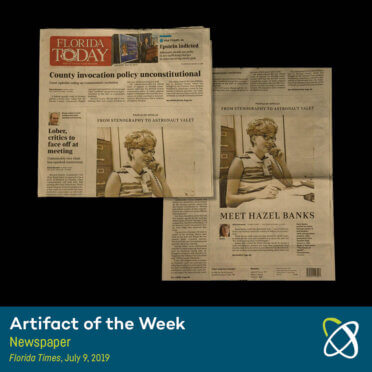Newspaper – Florida Times, July 9, 2019
Meet Hazel Banks, a clerk and stenographer who worked for NASA on the Mercury, Gemini, and Apollo programs up through Apollo 15. Banks started at NASA in 1965 in the procurement department working on contracts before moving to the flight training building at Kennedy Space Center to work with the astronauts. Reflecting on her career, she said it was “the most amazing time I could imagine.”

Did you know that thousands of women worked for NASA on the human spaceflight program? While it is difficult to get exact figures on how many women did so in the 1950s and 60s, we know that women played an important role in the overall success of the program. Women like Hazel Banks, who worked as a stenographer for NASA, but who also had the opportunity to work with the astronauts as they trained in simulations for the Gemini and Apollo spacecraft.
In reflecting on her career at NASA, Banks said that “We were all just so enthused and inspired by the space program and were so excited to work in whatever capacity we could.” While her statement captures the thrill felt by Americans during the space race of the 1960s, it also hints at the challenges women faced in the workforce at the time. The overall attitude toward women was that they could not do the same jobs as men. With the space program many thought it was acceptable for women to take on the more menial tasks, like secretarial work or sewing spacesuits, but more specialized roles in engineering, mathematics, and science were the domain of men.
We now know some of the hidden figures who successfully took on those male dominated jobs at NASA, working as “human computers,” code writers, and even training as astronauts despite this attitude toward women. Hazel Banks faced that prejudice every day, but she didn’t let it keep her from doing what needed to be done. “Through the years I’ve felt like the atmosphere was, ‘Well, you’re a woman, you’re just a secretary,’ that sort of thing,” she said. “But I remember just thinking it was great having the job that I did. Working with the astronauts…knowing how to handle things, learning how to get the job done.” Banks recognized that each and every person involved in the space program, man or woman, had an important role to play to ensure that the program was a success.
See more Artifacts of the Week
Artifact of the Month Video Series
Connect with curiosity!










